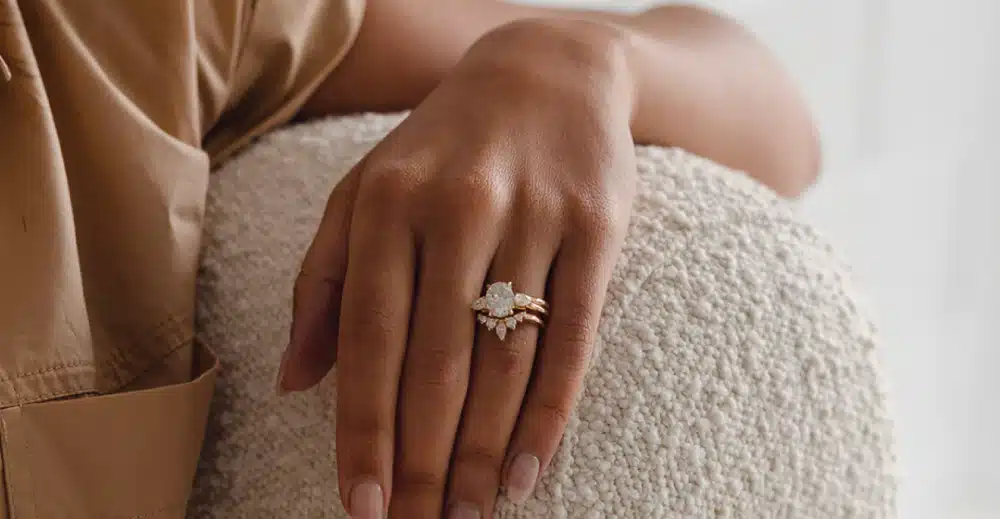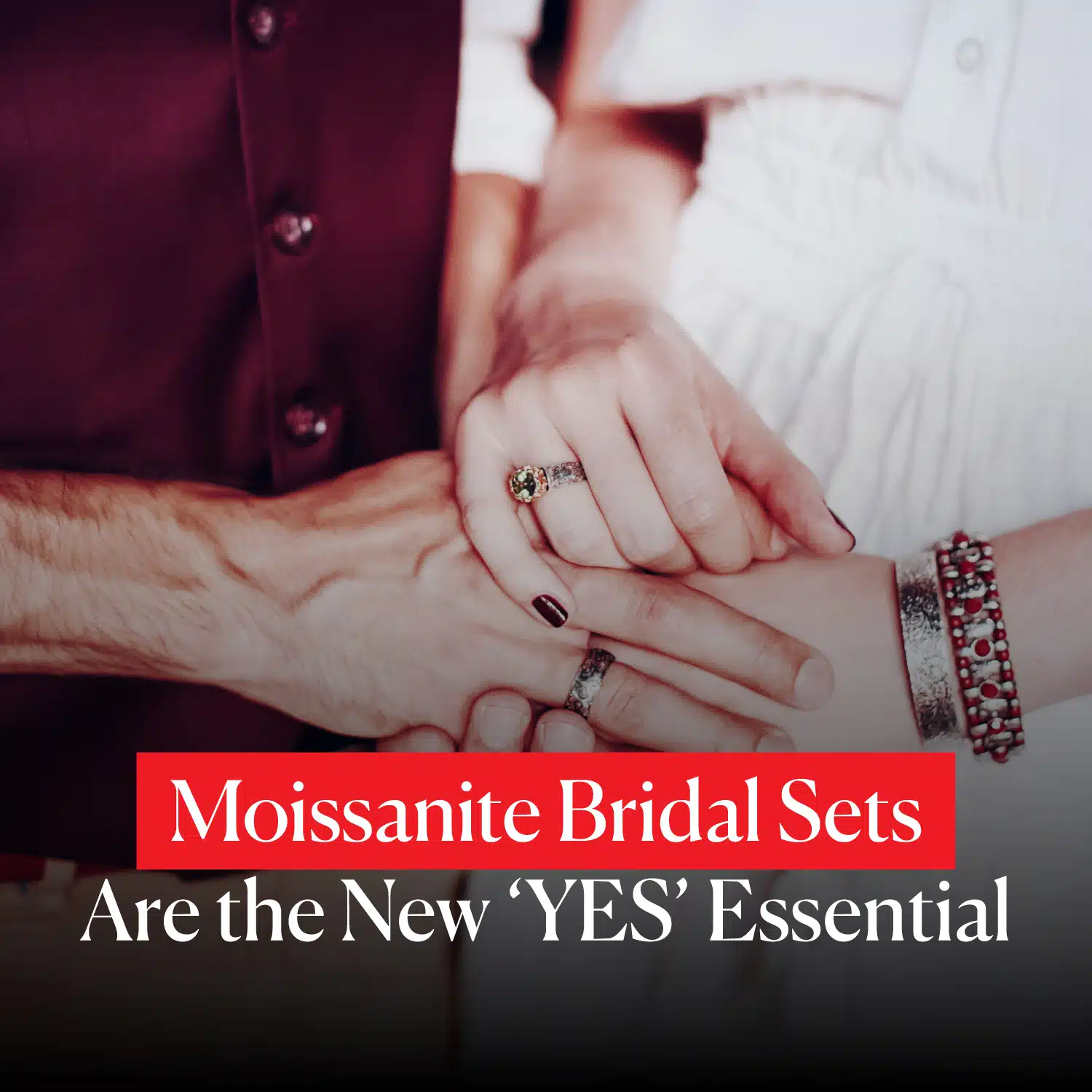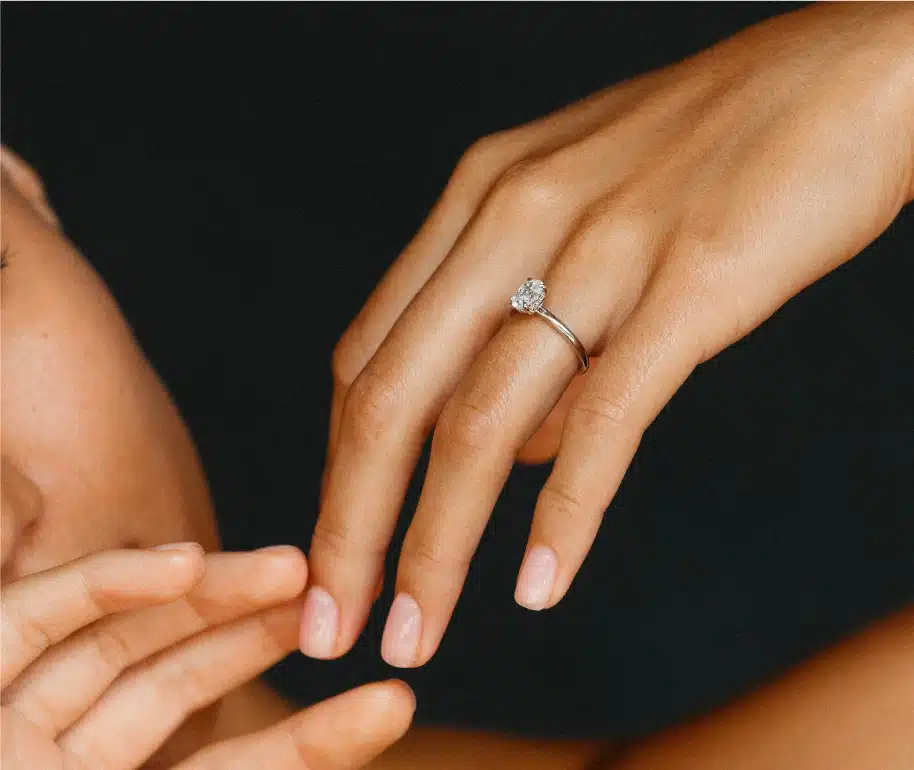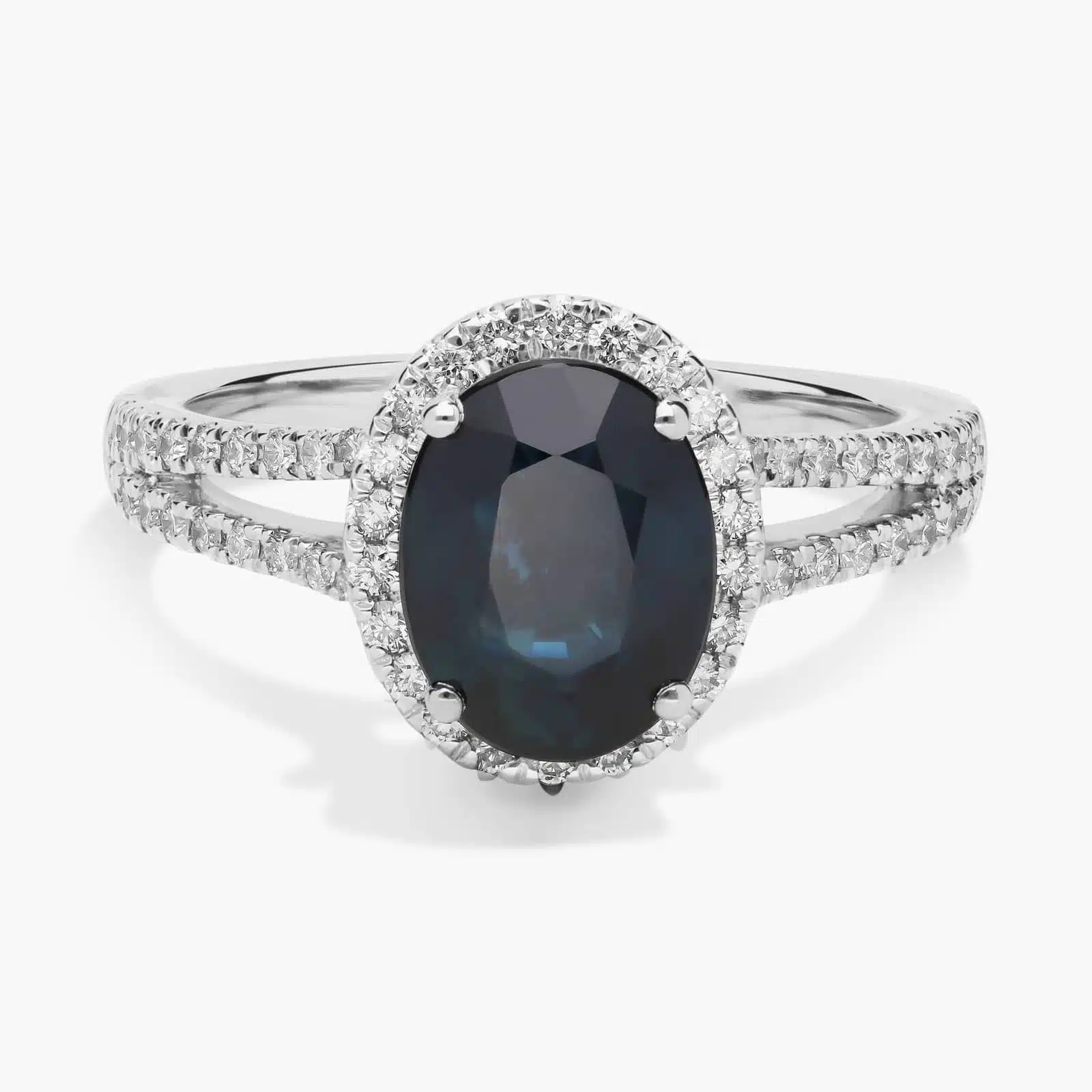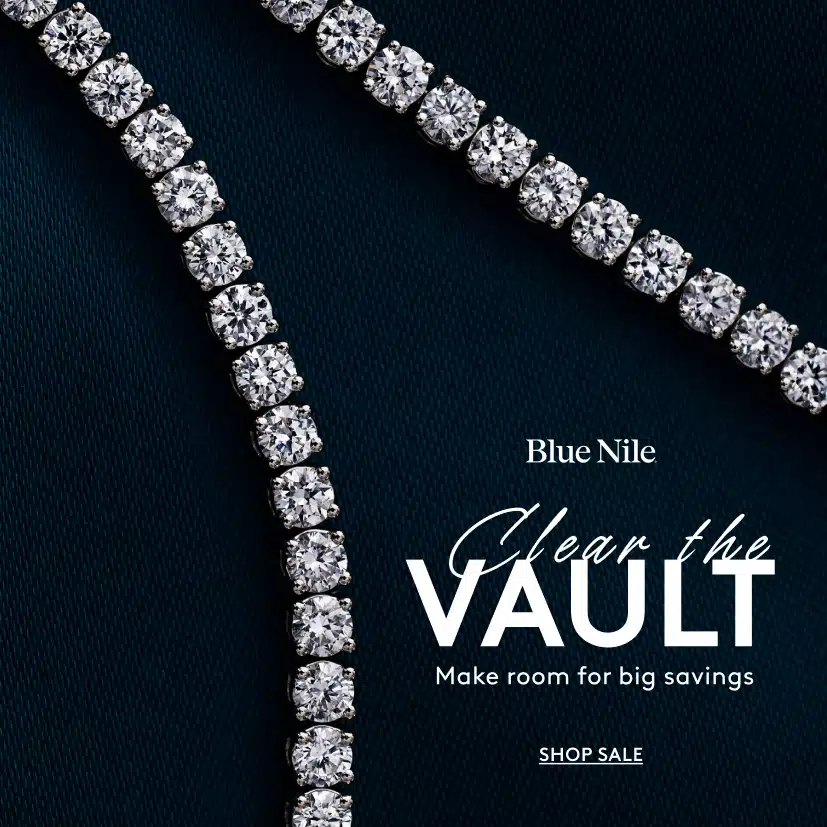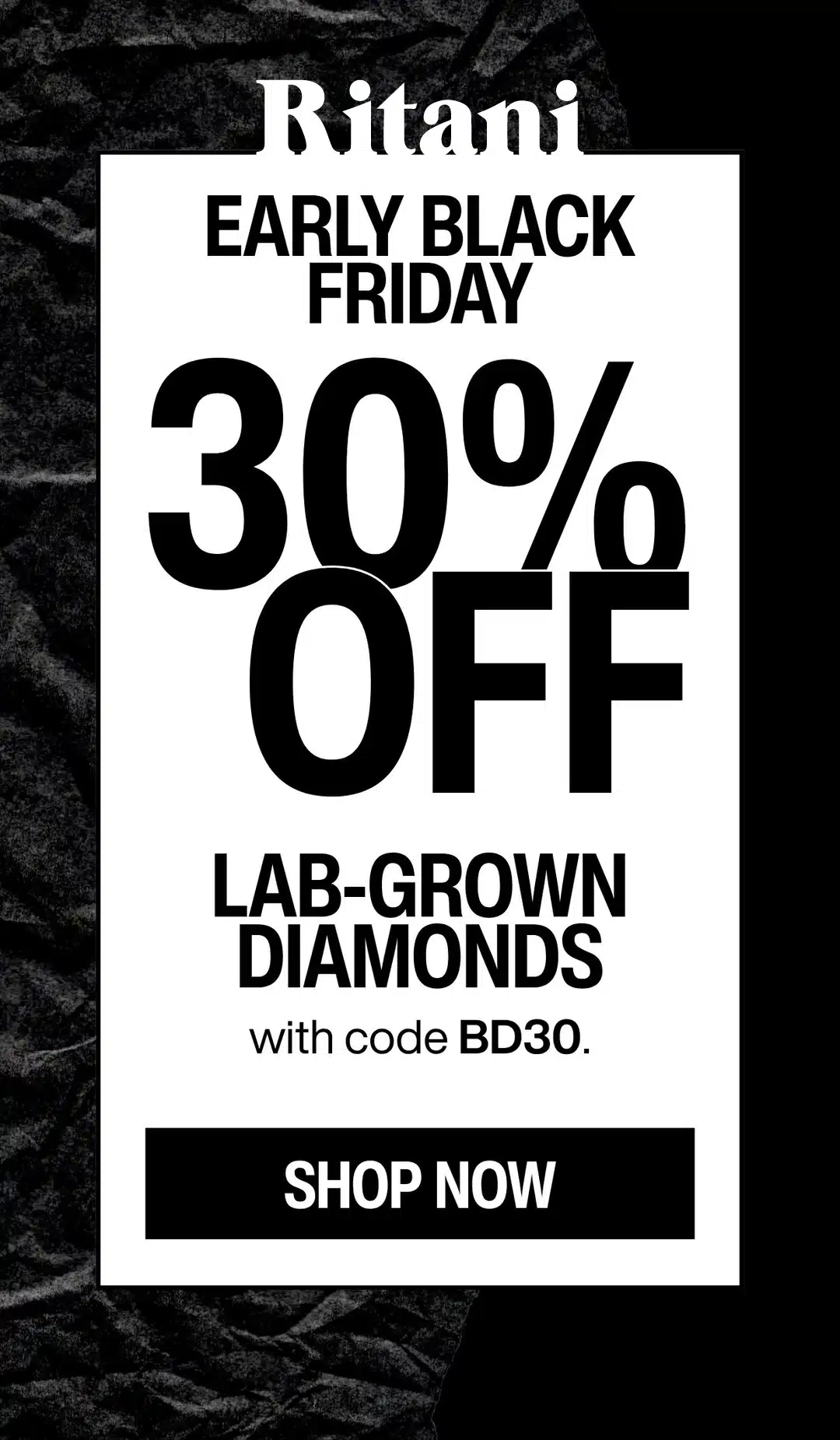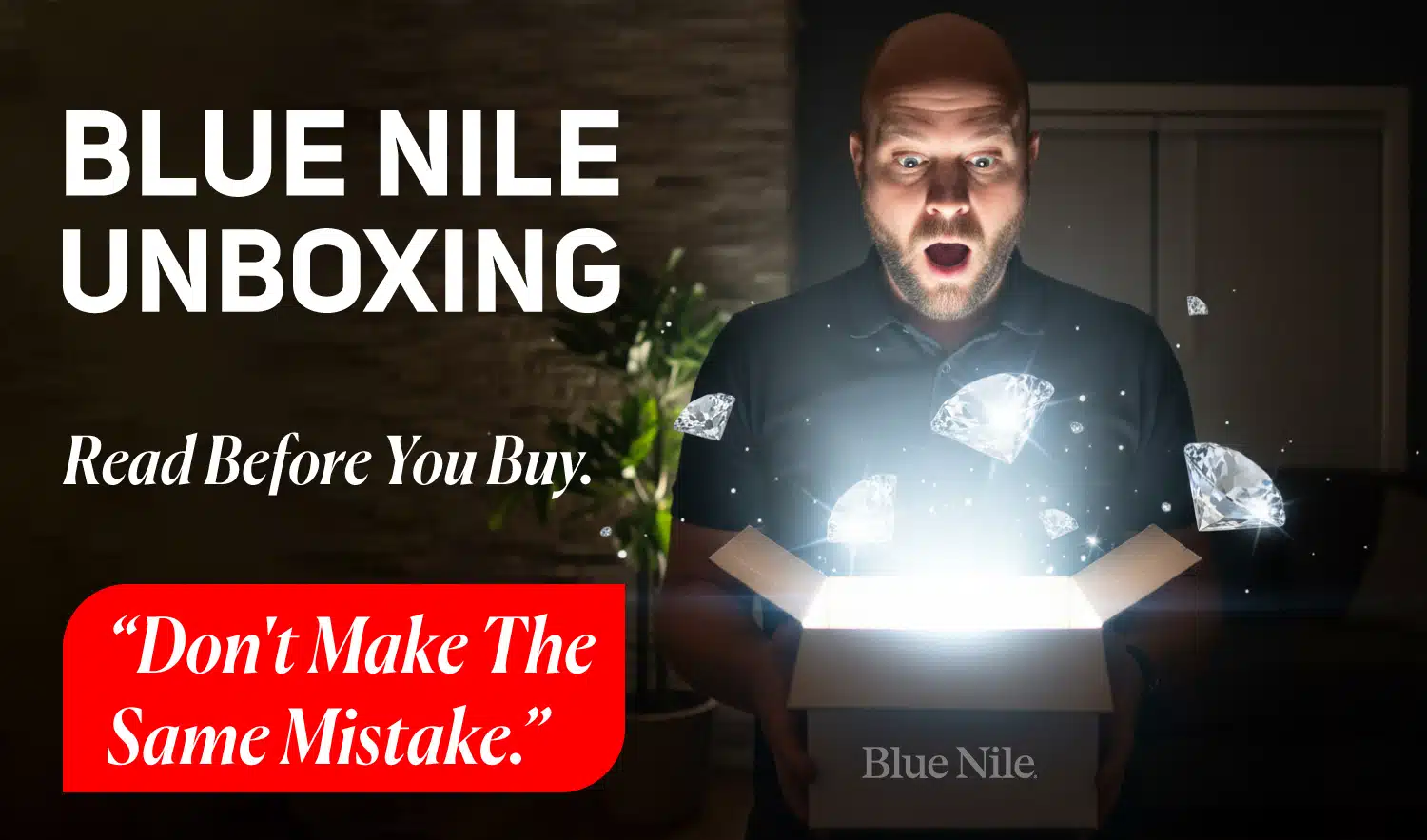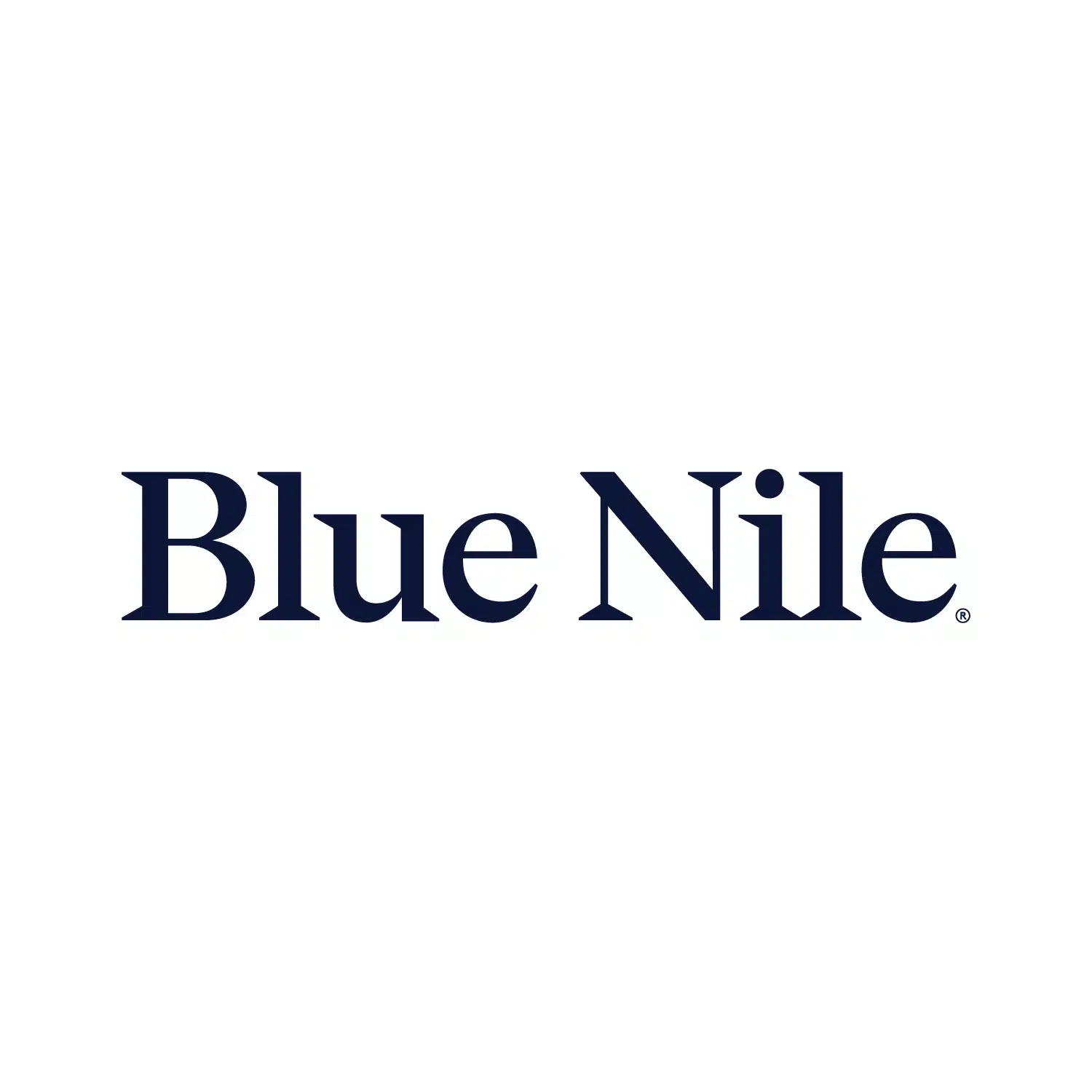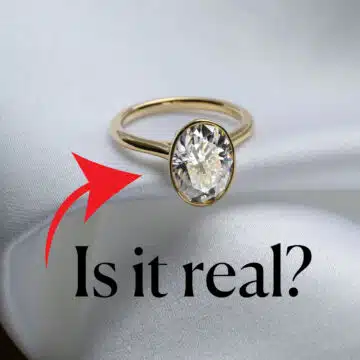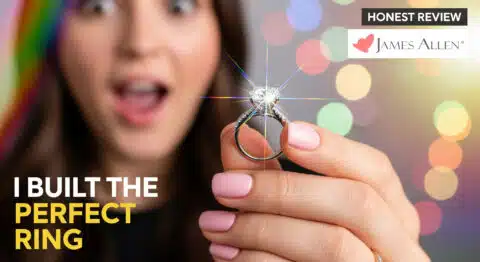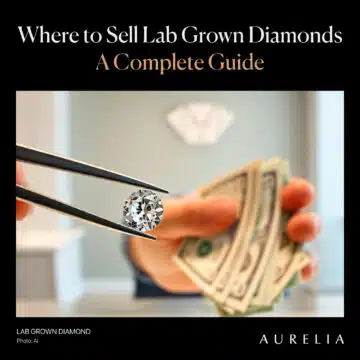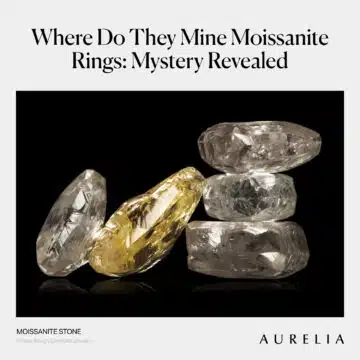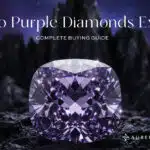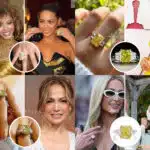Yes, my experience confirms that Blue Nile is an excellent and highly reputable source for engagement rings, delivering a premium product, secure packaging, and a trustworthy GIA-certified diamond; however, the online buying process has one crucial trap that you absolutely must avoid.
Buying an engagement ring online, sight-unseen, is a nerve-wracking act of trust. You see a beautiful diamond on your screen, but you’re haunted by questions: ‘What will it really look like? Will the packaging feel luxurious? Is this a mistake?’ I recently went through this entire process myself, and I want to share my brutally honest results. I ended up with a spectacular ring, but I also almost made a critical, thousand-dollar mistake that isn’t obvious on the website.
As your friend in the business, I am going to be your personal guide. I’m going to take you through my recent Blue Nile unboxing, step-by-step, to show you the real-world quality.
Then, I am going to walk you through the exact process I used to build the stunning 1.63ct oval lab-diamond ring from the image, including the ‘mistake’ you must avoid. Let’s get into it.
My Blue Nile Unboxing: The Verdict at a Glance
This article is a deep-dive case study into a real-world Blue Nile purchase. Here are my key findings from the experience, right upfront:
| Category | My Rating | Mehedi’s Key Finding |
| Packaging & Presentation | 5/5 | The unboxing experience felt incredibly premium, secure, and luxurious. Exactly what you want for an important purchase. |
| Ring Quality & Craftsmanship | 5/5 | The final product (both the diamond and setting) exceeded my high expectations. The quality is undeniable. |
| The Buying Process | 4.5/5 | The “Creative Studio” is a powerful tool, but it has one major potential trap (the “bowtie”) that requires an educated eye. |
The Bottom Line: My experience was overwhelmingly positive. Blue Nile delivered an A++++ product.
For my complete, in-depth rating of Blue Nile’s selection, pricing, and a comparison to other top retailers, please see my Official Blue Nile Review.
To give you a true first-person view of the entire experience, I’ve created a full video walkthrough of my unboxing and the step-by-step ring build—press play below to see the whole story unfold.
The Step-by-Step Unboxing Experience
Alright, the moment of truth has arrived. After all the research and the exciting process of building our ring online, a package from Blue Nile has landed on my doorstep. I want to walk you through this entire unboxing, step-by-step, to show you exactly what you can expect and to give you my honest, unfiltered first impression of the real-world quality.
This is the unboxing for the beautiful 1.63 Carat Oval Lab-Grown Diamond Petite Hidden Halo Ring we’ll be breaking down in a moment.
Step 1: The Anonymous Outer Box
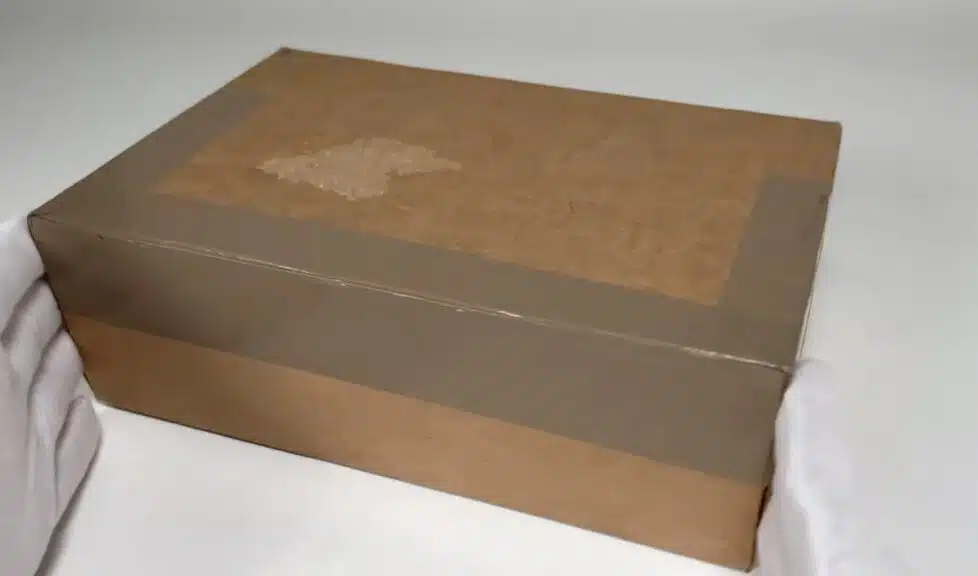
The first thing you see is… a completely plain, standard cardboard shipping box. And I have to tell you, this is exactly what you want. This isn’t a mistake or a sign of cheap packaging; it is a critical and very intentional security feature.
The last thing you want is a box arriving on your porch that screams “EXPENSIVE ENGAGEMENT RING INSIDE!” Blue Nile’s discreet packaging ensures your once-in-a-lifetime purchase arrives safely and securely, without attracting any unwanted attention. It’s the first sign of a professional, thoughtful process.
Step 2: The Luxurious Inner Box
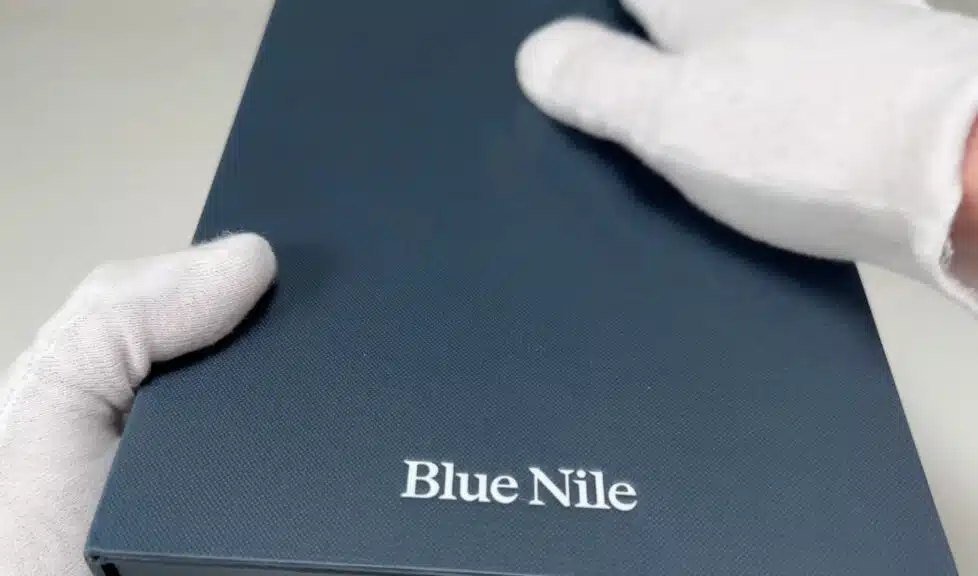
Once you open the outer shipping box, the real experience begins. Inside, you’ll find Blue Nile’s signature inner box. My first impression here is one of serious substance.
It’s a heavy, sturdy, and beautifully constructed box, wrapped in a deep blue, subtly textured material with the minimalist “Blue Nile” logo in clean white font.
This is the moment you transition from receiving a package to unveiling a piece of fine jewelry. It has a real sense of occasion and a premium feel that immediately builds confidence in the quality of what’s inside.
Step 3: The Presentation
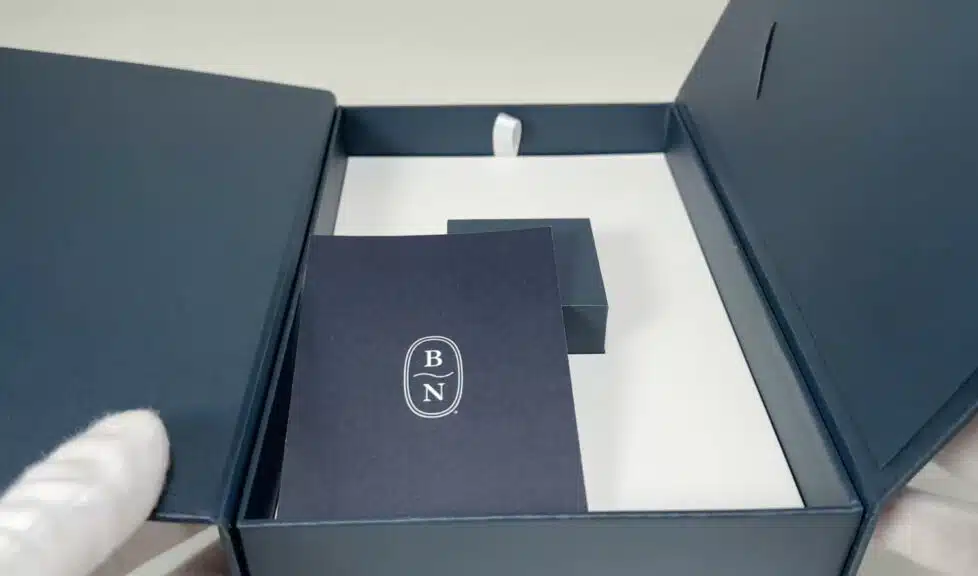
As you open the main box—which has a satisfying, magnetic closure—you’re greeted with a masterclass in presentation. On the left side, you’ll find a beautiful, dark blue folder.
This isn’t just a packing slip; it contains all your crucial documentation: the official diamond certificate (in our case, the GIA report), your appraisal for insurance purposes, and a receipt. This shows you that they consider the paperwork to be just as important as the ring itself.
On the right, nestled perfectly in the center, is the main event: the smaller, classic ring box. It’s a presentation that is clean, organized, and designed to build anticipation.
Steps 4 & 5: The Grand Reveal
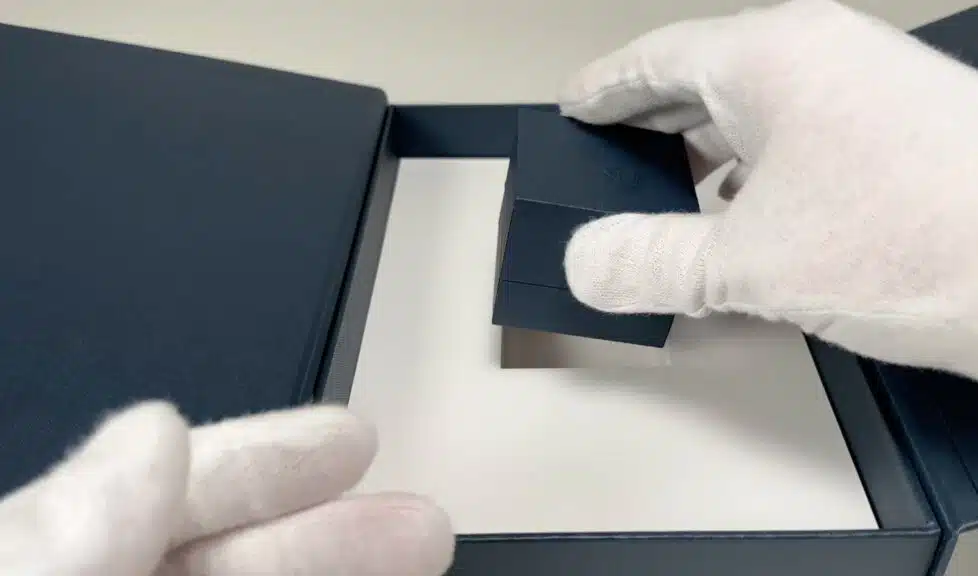
This is the moment your heart beats a little faster. You lift out the smaller, perfectly crafted ring box. You open the lid, and there it is, sitting in the center, catching the light for the very first time. My immediate reaction was a genuine “wow.”
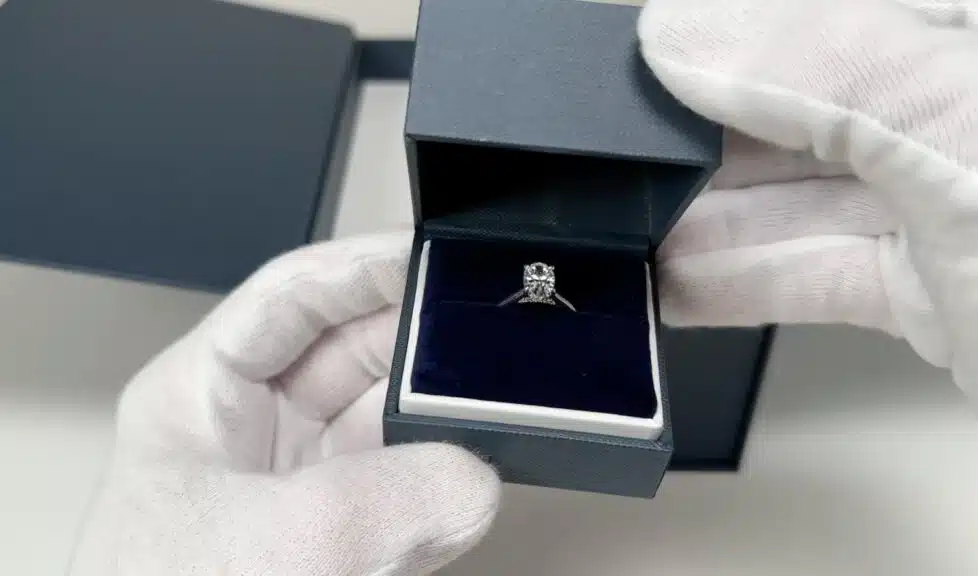
In that moment, you’re not just looking at a ring; you’re seeing the two distinct, high-quality components you so carefully selected come together for the first time.
You see the stunning 1.55 Carat D-VVS1 Oval Lab-Grown Diamond that we’ll be analyzing, and you see the expert craftsmanship of the beautiful Petite Hidden Halo Solitaire Plus setting holding it securely. The quality is immediately apparent.
From the Box to the Hand
Alright, the ring is out of the box. The presentation was A++++, but as a gemologist, I know that’s just the prelude. The real test is the ring itself. My goal now is to put this piece through the exact same inspection I would for any high-end piece of jewelry, looking at it not just as a consumer, but with the critical eye of an expert.
Step 6: My First Inspection (The Jeweler’s Loupe Test)
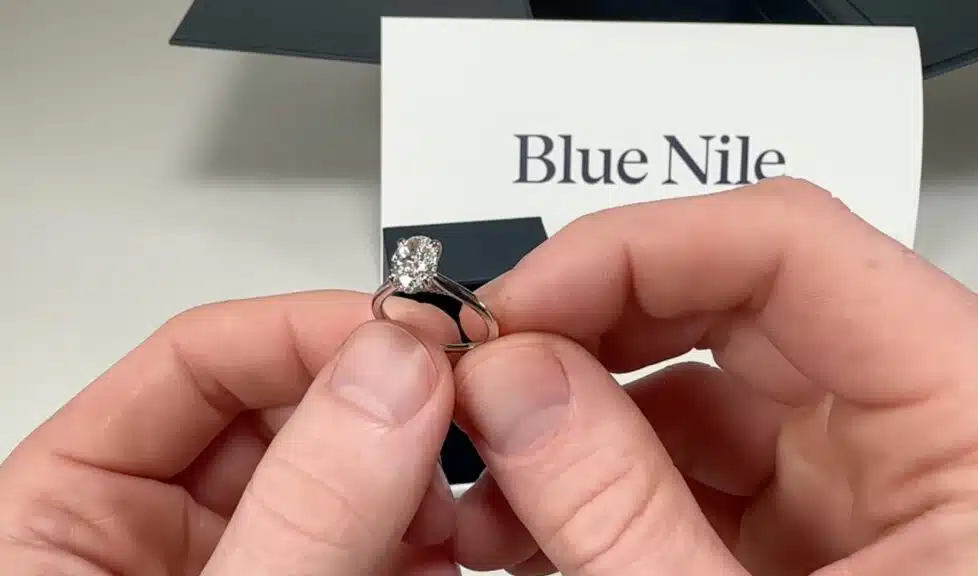
Before I even think about putting the ring on, my first move is to pick it up and get a feel for its substance. My initial impression is one of quality. The ring has a pleasant, solid weight to it—a clear sign that it’s made of solid 14k gold, not a hollow or flimsy imitation.
Now, for the part you can’t see in a standard photo—my “loupe test.” A jeweler’s loupe is a small magnifying glass we use to inspect the fine details of craftsmanship. Here’s what I was looking for, and what Blue Nile delivered:
The Prongs: This is my first and most important checkpoint. Are the prongs substantial enough to hold the diamond securely? Are they perfectly spaced and uniform in size? And most critically, are they set flush against the diamond with no gaps? On this ring, the answer is yes across the board. The prongs are expertly crafted—delicate enough to be elegant but strong enough to be secure.
The Polish: I’m looking for a flawless, mirror-like finish on the metal of the band, with no tiny scratches or imperfections from the manufacturing process. The polish on this ring is impeccable.
The “Hidden Halo” Craftsmanship: This is where you can really judge a jeweler’s skill. Setting those tiny pavé diamonds in the hidden halo is incredibly precise work. Under my loupe, I can see that each of the 26 tiny accent diamonds is securely set, perfectly aligned, and of a consistent, high quality (G-H color, VS2-SI1 clarity). This is the kind of detail that separates a good ring from a truly great one.
Step 7: The “On-Hand” Test (The Real-World Light Test)
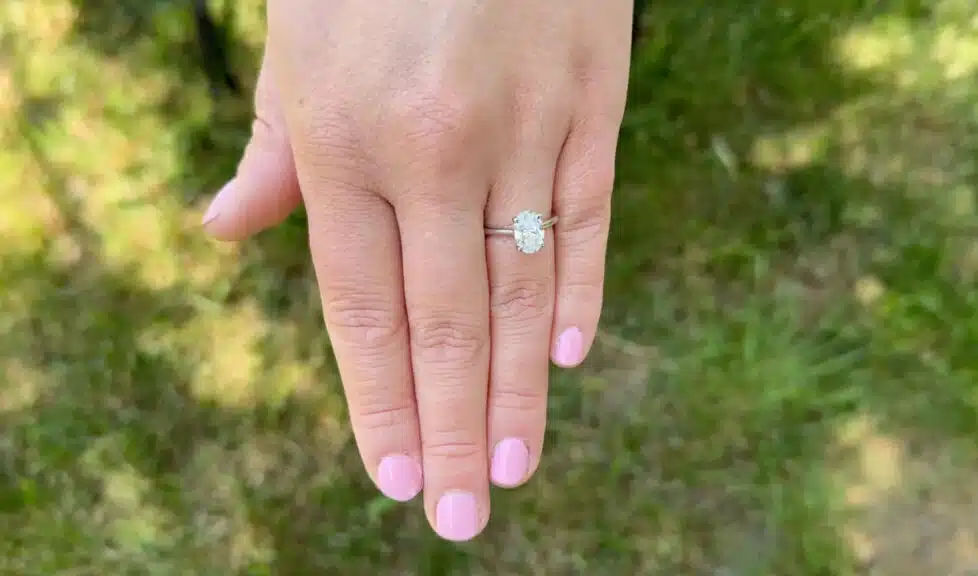
A diamond ring can look fantastic in the perfect lighting of a photo studio (or an online 360° video). But the single most important question—the one every single buyer is dying to know—is: “What does it look like in the real world?”
This is the ultimate test. The moment you take it out of the box and put it on a hand, under normal, natural light, is where a diamond’s true brilliance is either revealed or exposed. I’m looking for that “life” in the stone, that brilliant flash and fire that you can see from across the room.
And I can tell you, this 1.63 Carat Oval Lab-Grown Diamond did not disappoint. The moment it’s on a hand and moving in the light, the “Excellent” polish and “Ideal” cut grades from its certificate come to life.
The stone is incredibly brilliant, with a beautiful “crushed ice” facet pattern that throws off a ton of sparkle. Crucially, as you can see in the photo, there is no noticeable, distracting bowtie effect. This is the clear result of choosing a well-cut stone and a testament to the quality of the diamond itself.
This real-world performance is the final and most important confirmation of quality. Blue Nile’s product is not just beautiful on a screen; it is genuinely spectacular in person.
My Step-by-Step Process & The “Mistake” I Almost Made
Alright, the unboxing and real-world inspection have proven that Blue Nile can deliver a truly A++++ product. Now, I want to switch gears and walk you through the most crucial part: the process. How did I end up with that spectacular ring?
I’m going to take you through my exact thought process, step-by-step, for building the 1.63 Carat Oval Lab-Grown Diamond Petite Hidden Halo Ring. This is where I’ll reveal the single most important ‘mistake’ you must avoid when shopping for a fancy-shaped diamond online.
Step 8: Selecting the Perfect Lab Diamond
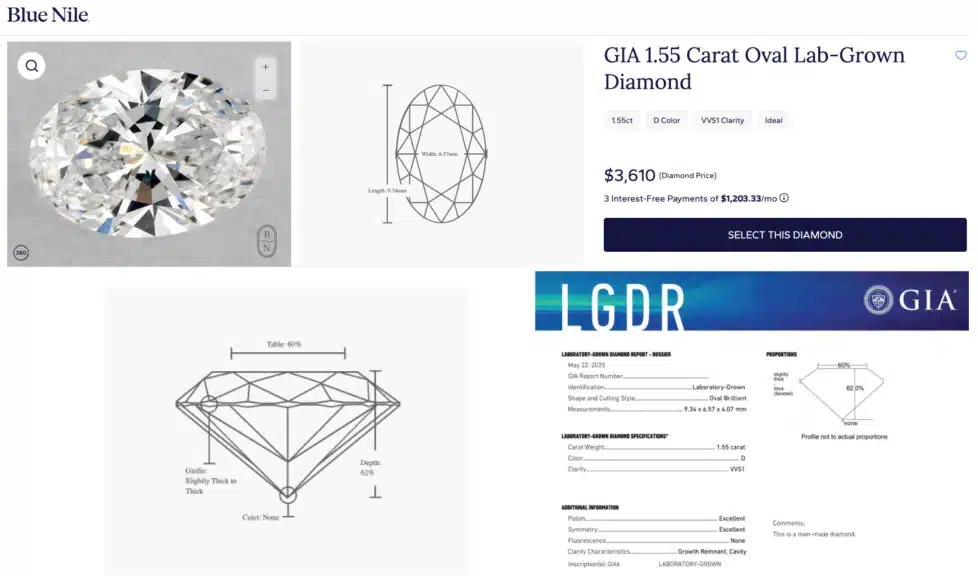
This is where the magic begins. My goal was to create a truly spectacular, heirloom-quality ring. For that, I needed a center stone with top-of-the-line specifications.
I started my search for an oval lab-grown diamond with the following “sweet spot” in mind: around 1.5 carats, D-F Color, and at least VS1 Clarity.
My search led me to this stunning GIA 1.55 Carat D-VVS1 Oval Lab-Grown Diamond. Let’s break down why this stone looks perfect on paper:
- Carat Weight: 1.55 Carats. This is a substantial and very impressive size, offering that big, finger-covering look that ovals are so famous for.
- Color: D. This is the absolute highest possible color grade—perfectly, flawlessly colorless. A true collector’s grade.
- Clarity: VVS1. This is an elite clarity grade. It means any inclusions are so microscopic that even a trained gemologist has difficulty finding them under 10x magnification.
- Cut, Polish & Symmetry: All “Excellent.” A Triple Excellent grade is my non-negotiable for ensuring a diamond’s sparkle potential.
- The Certificate: Critically, this is a GIA certified lab-grown diamond. While IGI is the standard for lab diamonds, seeing a GIA report is often a sign that the manufacturer has submitted it to the strictest lab as a mark of premium quality. For a deep dive, our IGI vs. GIA Guide explains this modern market dynamic in full detail.
Now, at this point, 99% of buyers would see this flawless resumé and click “Select This Diamond” without a second thought. And that would be a huge mistake.
The “Mistake”: Trusting the Paper Over Your Own Eyes
My initial, excited instinct was to immediately select this flawless D-VVS1. It’s a perfect stone on paper. But as an expert, I know that for a fancy shape like an oval, the certificate is only half the story.
The mistake I almost made was not meticulously scrutinizing the 360-degree video. Ovals, even ones with perfect specs, are notorious for the “bowtie effect”—a dark, bowtie-shaped shadow that can appear across the center of the stone due to its complex faceting.
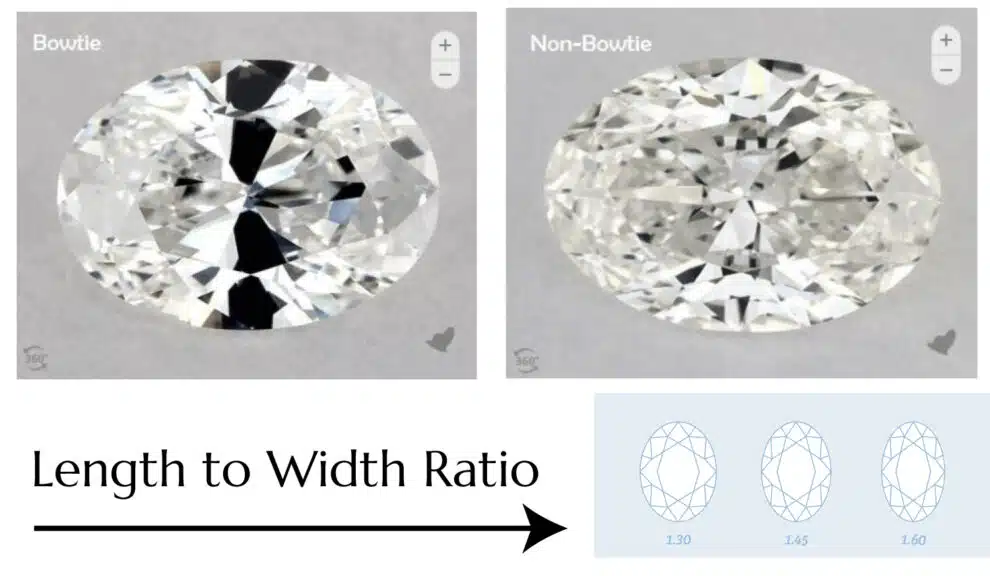
This is not a flaw that is listed on the GIA report, but it can absolutely kill a diamond’s brilliance in real life. You must trust your eyes, not just the paper.
So, I did what every savvy buyer must do. I watched the video of the 1.55-carat diamond over and over. It was beautiful, but I could see a faint but persistent bowtie. I then continued my search and found the final 1.63-carat diamond used in the ring.
While its specs were nearly identical, its 360-degree video showed superior light performance. It had a more brilliant, even sparkle with virtually no noticeable bowtie. It was a visually more impressive stone, even if their certificates looked the same.
For an in-depth guide on what to look for specifically in this shape, our Oval Cut Diamond Buying Guide is a must-read.
Step 9: Selecting the Perfect Setting
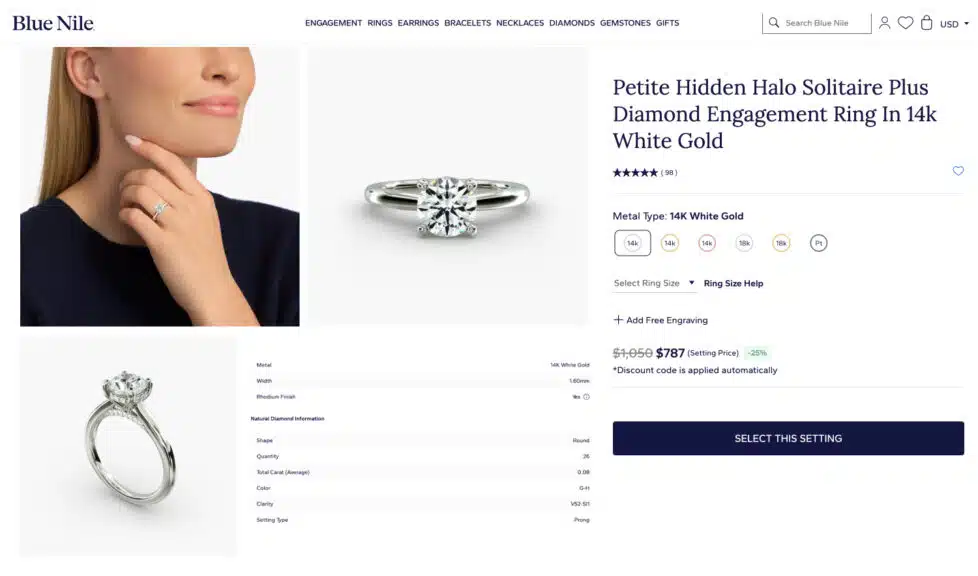
Once you’ve found your perfect diamond, choosing the setting is the fun part. My goal was a setting that felt timeless but had a touch of modern, secret sparkle. That’s why I chose the “Petite Hidden Halo Solitaire Plus” setting in 14k White Gold.
Here’s why I think this setting is a work of genius:
- The Best of Both Worlds: From the top, it looks like a classic, elegant solitaire. It puts all the focus on that magnificent 1.63-carat oval.
- The Secret Sparkle: But from the side profile, you get the “hidden halo”—a delicate basket of pavé diamonds that cradles the main stone. It’s a detail that only the wearer can truly see, adding a beautiful and personal touch of glamour without being overpowering.
- It Makes the Diamond Look Bigger: That hidden halo acts as a brilliant base, reflecting more light up into the oval and making it appear even larger and more brilliant than it already is.
Step 10: The Final Ring & The Verdict
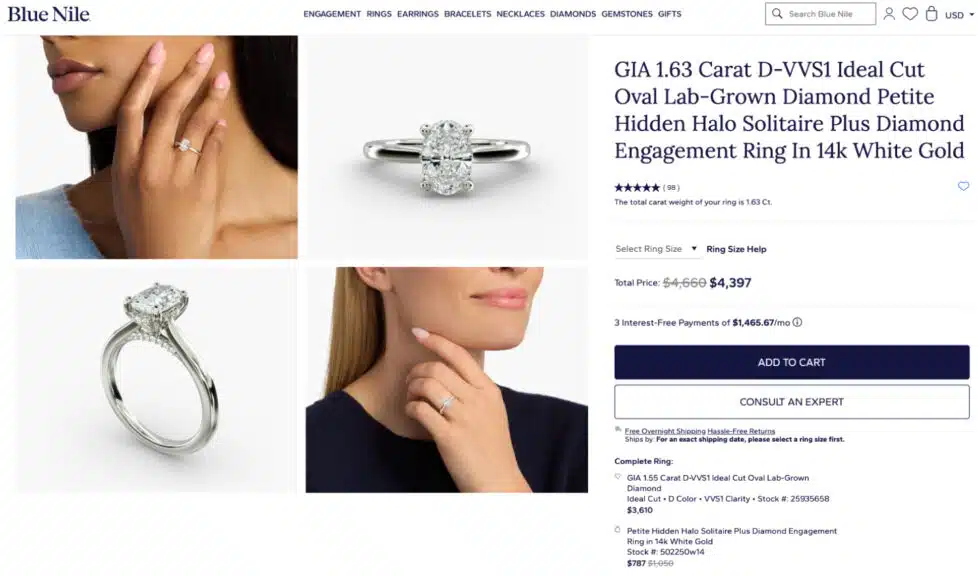
And here we have it. This final page shows the beautiful result of our careful choices. It clearly lists our stunning GIA 1.63 Carat D-VVS1 Oval Lab-Grown Diamond and our chosen Petite Hidden Halo setting, with a final, itemized cost of $4,397.
My Final Verdict: This is a spectacular, heirloom-quality ring that looks like it could easily cost $20,000 or more if it were a natural diamond. The quality is undeniable, the design is sophisticated, and the value is absolutely incredible, all thanks to a smart, transparent building process.
This entire journey is powered by their amazing ring builder, a tool we break down from start to finish in our complete guide to the Blue Nile Creative Studio.
Your Blue Nile Questions, Answered
You’ve seen my unboxing and my step-by-step guide. Now, let’s tackle the big, important questions that every savvy buyer has before they commit. Here are my brutally honest, expert answers.
The Verdict: A Premium Experience with One Crucial Catch
My final verdict after this entire experience is overwhelmingly positive, cementing the high marks I give them in my full Official Blue Nile Review for 2024. The quality of the final ring is exceptional, the unboxing feels luxurious, and the value for money is undeniable. But the “mistake” I almost made is the single most important lesson of this entire process.
The crucial lesson is this: you must be the final judge. A flawless certificate is a fantastic starting point, and it’s essential for verifying the quality of even their most premium collections, like the ones we analyze in our Astor by Blue Nile Cut review.
But the 360° video is your most powerful tool. By using your own eyes to confirm the diamond’s real-world beauty and light performance, you can use a vendor like Blue Nile to build the perfect ring with absolute and total confidence.
Trust the process, but always, always trust your eyes.
Blue Nile is one of the biggest and most recognized online jewelry retailers, offering an extensive and exclusive inventory. Their high-resolution images are improving and getting closer to the quality offered by James Allen, while their prices remain highly competitive. Right now, Blue Nile offers up to 30% savings on jewelry during a limited-time sale.
WHAT WE LOVE ABOUT THEM:
- 30-day no-questions-asked return policy, with a prepaid shipping label provided by Blue Nile.
- Lifetime warranty on all purchases.
- Free shipping on every order.
- Complimentary services every six months, including prong tightening, repolishing, rhodium plating, and cleaning.
- Insurance appraisal included with your purchase.
- One free resizing within the first year.
- High-quality images available for roughly half of their diamond selection.
- 24/7 customer service support.
- Full credit toward future upgrades, as long as the new item is at least double the value.
- Best-in-class order fulfillment process.


